By Morgan Linn
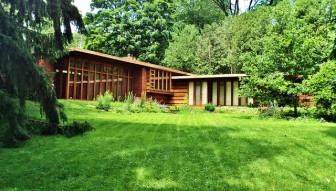
Herbert and Katherine Jacobs House in Madison, WI. Designed by Frank Lloyd Wright. Image: Flickr
Ten of the most significant buildings designed by architect Frank Lloyd Wright, including four in Illinois and Wisconsin, have a chance to become a UNESCO World Heritage Site this summer.
Every year the United States can nominate two nationally important sites for international recognition – one cultural and one natural. They are chosen from a tentative list of sites that meet nomination criteria from the United Nations Educational, Scientific and Cultural Organization.
The buildings were on the list for seven years until the National Park Service submitted a 426- page nomination to the World Heritage Centre in early 2015, said Joel Hoglund, communication and events manager for the Frank Lloyd Wright Conservancy in Chicago.
Wright “is widely considered to be America’s greatest architect and one of its most significant artists. In a remarkable career spanning over 70 years, he created over 1,000 designs, 500 of which were realized,” according to the conservancy.
They are now being considered for designation — technically known as inscription — by the World Heritage Committee, he said.
Inscription would mean the buildings would finally become world heritage sites and be internationally recognized as culturally significant.
The conservancy expects to hear whether the sites are approved this summer, possibly in July, Hoglund said. The United States has 23 World Heritage. sites including Yellowstone National Park, the Grand Canyon and the Statue of Liberty.
UNESCO created the concept of world heritage sites that are intended to build “intercultural understanding through protection of heritage and support for cultural diversity,” according to its website.
To qualify for the designation, an area must fit at least one of 10 criteria. The Wright buildings were nominated because they represent “a masterpiece of human creative genius” and “exhibit an important interchange of human values, over a span of time or within a cultural area of the world.”
Four of the 10 buildings are in Great Lakes states:
* Unity Temple in Oak Park, Illinois
* Frederick C. Robie House in Chicago
* Herbert and Katherine Jacobs House in Madison, Wisconsin
* Taliesin in Spring Green, Wisconsin
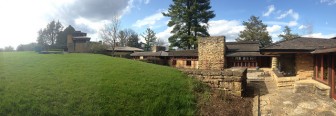
Taliesin in Spring Green, WI. Image: Flickr
The sites were submitted under a joint nomination, meaning the Frank Lloyd Wright Building Conservancy worked on the proposal with representatives from all 10 buildings, Hoglund said.
All four sites already are national historic landmarks, and Taliesin was Wright’s home and studio for many years.
There are many benefits to becoming a world heritage site, according to the National Park Service. Prestige and international recognition, increased tourism, enhanced fundraising ability, and a bit of added protection are perks of a designation.
Nomination “elevates the site on the world state. It makes it more visible to people in other countries so they recognize the significance of things here in the United States,” said Dean Alexander, the superintendent of Hopewell Culture National Historical Park and Dayton Aviation Heritage National Historical Park, two Ohio sites also under consideration.
The nominations would also bring more tourism, Alexander said.
Several other sites in the Great Lakes region are on the United States’ tentative list and working toward nomination.
The Dayton Aviation Site is culturally important because it’s where the Wright brothers invented the airplane.
“It’s the site of an invention that’s had a major impact on travel, commerce, human relations and migration,” Alexander said.
The site would fit under the UNESCO criterion of exhibiting “an important interchange of human values” over time in the development of technology.
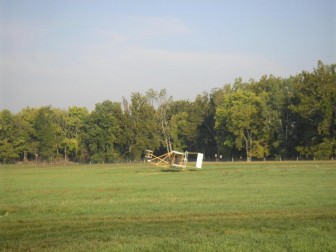
Wright Flyer 3 replica at Huffman Prairie at Dayton Aviation Heritage National Historical Park. Image: National Park Service
The designation would include three parts of the Dayton Aviation Heritage National Historical Park, plus Hawthorn Hill, which is owned by the Wright Family Foundation, but may be added to the national park as well, according to the site’s tentative list information.
Before proceeding with nomination, there is still one more historic property that needs to be added, Alexander said.
“It’s not in protected ownership yet,” he said. “That’s the airplane factory the Wright brothers built when they started their company to build airplanes. So basically it’s the first built airplane factory in the world.”
After the factory is purchased, nomination plans will move forward and preparations for submitting nomination documents will start.
“We’re hoping that we can purchase those buildings in 2017,” Alexander said.
Another nomination is in the works, and farther along than the Dayton sites: Hopewell Ceremonial Earthworks in the south-central part of the state.
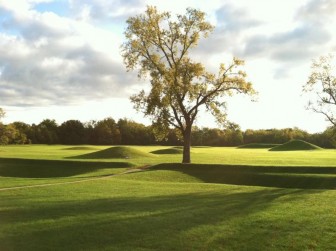
Mound City group at Hopewell Culture National Historical Park. Image: National Park Service
The area has “really unique large earthworks sites – earthwork constructions in the shape of various geometric shapes,” Alexander said. “Some of them have these really complex solar and lunar alignments. Some of them are big enough that you could take all of Vatican City and put it inside.”
Like the Wright buildings, it would be a multisite nomination, Alexander said. It includes several earthworks and mounds, Hopewell Culture National Historical Park and Fort Ancient State Memorial.
The National Park Service and the Ohio History Connection are working jointly to nominate the Hopewell sites, said Brad Lepper, the curator of archaeology for the Ohio History Connection.
Alexander said the ceremonial sites contain artifacts made from materials brought from Canada and some all the way from the Gulf Coast. There are about 200 pounds of obsidian from Yellowstone National Park.
“Most people don’t know about it, and that’s why we want it on the world heritage list,” Alexander said. He and his colleagues have drafted about half of the nomination so far.
“We’re looking at maybe 2018 when we can actually formally submit the nomination,” he said.
Finally, Serpent Mound, a national historic landmark in Adams County, Ohio, is also on the list of sites to be nominated.
Since the Ohio History Connection is currently focusing efforts on the Hopewell sites, it will start working on the Serpent Mound nomination once the Hopewell nomination is submitted.
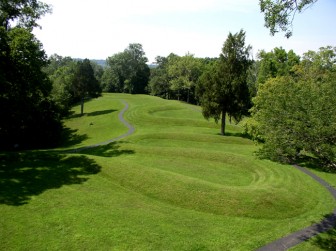
Serpent Mound. Image: Wikipedia
Lepper said Serpent Mound is “the largest effigy mound in the world. It’s really superbly elegant. Its scale alone – being the biggest of anything – makes it pretty special.”
The mound’s construction incorporates astronomical alignments, Lepper said.
Tim Goodwin, the manager of the Serpent Mound, said, “From one end of the serpent to the other, it measures 1,348 feet. Every single American history book in the United States will probably have a picture of Serpent Mound representing Native American heritage.”
Goodwin said the mouth of the serpent points directly at the setting sun of the summer solstice. Other parts line up with the rising sun for the spring equinox, the fall equinox and several moon alignments.
The most important reason for nominating both the Hopewell sites and Serpent Mound is recognition.
Lepper said the mound is part of an indigenous cultural tradition that has been harmed tremendously, making recognition of the site important.
“It’s a powerful statement that these monuments of indigenous American Indian heritage are equally important to the cultural achievements of any other culture in the world and deserve to be discussed and considered right alongside those,” he said.
There would also be the added benefit of increased cultural tourism, which would financially benefit local communities and reinforce the ethic of preserving indigenous American sites, Lepper said.
The tentative list of sites eligible for the nomination process is being revised, according to the National Park Service. New sites will be added to the list this fall after the Department of the Interior narrows down potential candidates.